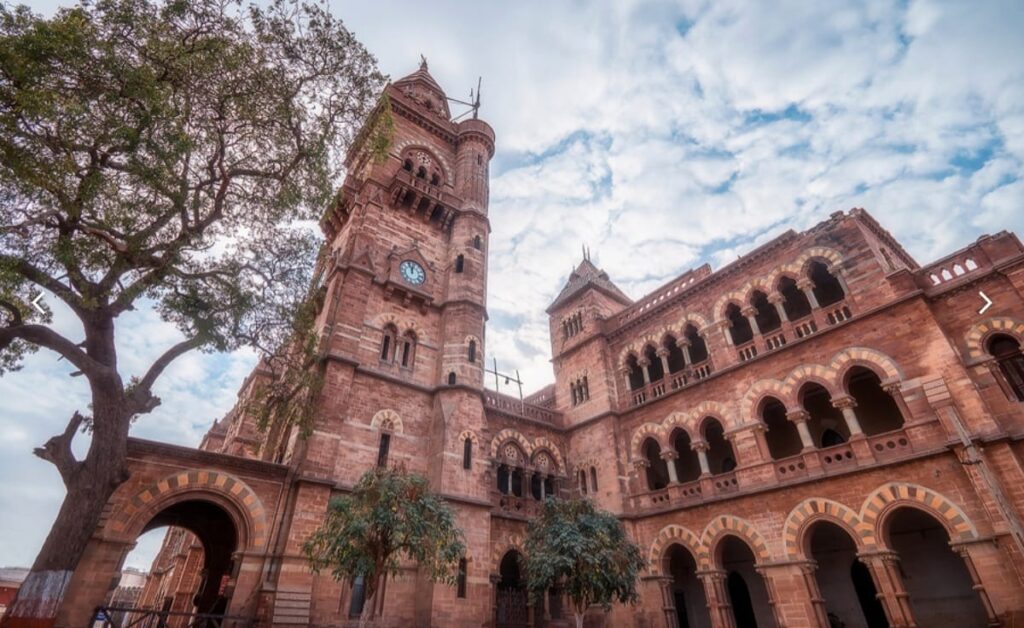Prag Mahal: A Stunning Architectural Marvel in Bhuj, Gujarat

Introduction
India houses numerous historical monuments that reflect the country’s rich cultural and architectural heritage. One such remarkable structure is Prag Mahal, a 19th-century palace in Bhuj, Gujarat. Known for its stunning Italian Gothic architecture, the palace showcases a fusion of European and Indian styles. Maharaja Pragmalji II commissioned the construction of Prag Mahal, and it continues to attract history enthusiasts, architects, and tourists from around the world. This article delves into the history, architecture, and significance of this extraordinary landmark.
History of Prag Mahal
Maharaja Pragmalji II commissioned Prag Mahal in 1865, and builders completed it in 1879. Colonel Henry Saint Wilkins, a British architect, designed the palace, incorporating Italian Gothic elements into its structure. The construction cost approximately 3.1 million rupees, a substantial amount during that era. European artisans and Indian craftsmen worked together to bring this grand vision to life, making it a unique architectural masterpiece in India.
Despite suffering damage during the 2001 Gujarat earthquake, restoration efforts have helped to retain its appeal. It continues to symbolize Gujarat’s royal history and architectural brilliance.
Architectural Features of Prag Mahal
Prag Mahal impresses visitors with its design, which seamlessly blends European influences with traditional Indian elements. Some key architectural highlights include:
1. Gothic-Style Architecture
Prag Mahal stands out as one of the few palaces in India designed in the Italian Gothic architectural style. Its pointed arches, ribbed vaults, and intricate carvings reflect European aesthetics, making it a rare and distinguished monument in the country.
2. Clock Tower and Durbar Hall
The palace features a clock tower that rises 45 meters (148 feet), offering breathtaking views of Bhuj city. The Durbar Hall, or royal assembly hall, boasts intricate chandeliers, Corinthian pillars, and ornate statues. The grandeur of the hall reflects the opulence of the Kutch rulers.
3. Red Sandstone and Decorative Elements
Builders used red sandstone from Rajasthan to construct the palace, adding a striking contrast to its surroundings. The detailed jali (lattice) work and sculpted motifs showcase the craftsmanship of Indian artisans.
4. Expansive Courtyard and Corridors
The palace boasts spacious corridors and courtyards, featuring elaborate pillars and arches. These elements enhance its visual appeal while also providing a sense of openness and grandeur.
Cultural and Historical Significance
Prag Mahal represents not just architectural excellence but also Gujarat’s royal heritage. Over the years, it has served multiple purposes, from functioning as a royal residence to housing government offices. Today, it remains a historical site, offering visitors a glimpse into the grandeur of the Kutch rulers.
Bollywood films have also featured the palace, further cementing its place in Indian pop culture. Movies like Lagaan and Hum Dil De Chuke Sanam have showcased its stunning interiors, bringing its beauty to a wider audience.
Visiting Prag Mahal
Prag Mahal attracts history buffs, architecture enthusiasts, and tourists exploring Gujarat. Here are some essential details for visitors:
- Location: Bhuj, Gujarat, India
- Timings: 9:00 AM to 5:00 PM (Closed on public holidays)
- Entry Fee: Nominal entry charges apply
- Best Time to Visit: October to March, when the weather remains pleasant
- Nearby Attractions: Aina Mahal, Kutch Museum, and Hamirsar Lake
Restoration and Preservation Efforts
The 2001 Gujarat earthquake caused significant damage to Prag Mahal, leading to structural cracks and the loss of some architectural elements. However, local authorities and heritage conservation organizations have worked to restore and preserve the palace. Their efforts have helped maintain its structural integrity while allowing tourists to experience its historical grandeur.
Conclusion
Prag Mahal stands as a striking example of architectural excellence, blending European design with Indian craftsmanship. Despite facing challenges over the years, it continues to captivate visitors with its grandeur and historical significance. A visit is more than just a journey through history—it offers an experience of Gujarat’s rich cultural heritage. Whether you are an architecture enthusiast, a history lover, or a traveler seeking unique destinations, Prag Mahal is a site that should not be missed.
By preserving and promoting such magnificent structures, we ensure that future generations can appreciate the artistic and historical legacy of India’s royal past.






